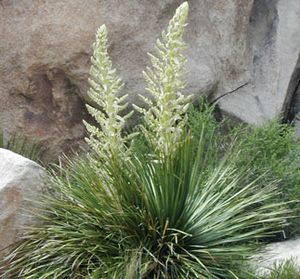Parry's beargrass facts for kids
Quick facts for kids Parry's beargrass |
|
|---|---|
 |
|
| Scientific classification | |
| Synonyms | |
|
Nolina parryi, also known as Parry's beargrass, is a special flowering plant. It grows naturally in Baja California, southern California, and Arizona. You can find this plant in both hot deserts and cool mountains. It can grow very high up, sometimes as high as 2100 meters (about 6,900 feet)!
What it Looks Like
Nolina parryi is a very tall plant. It can grow taller than two meters (about 6.5 feet). Its flower stalk, called an inflorescence, can reach an amazing 4 meters (about 13 feet) high! The main stem, or trunk, can be as wide as 60 centimeters (about 2 feet) across.
- Leaves: The plant has many stiff, long leaves. They grow in a tight circle, like a rosette. Each plant can have up to 220 leaves. These leaves can be as long as 140 centimeters (about 4.5 feet) and 4 centimeters (about 1.5 inches) wide.
- Flowers: Nolina parryi has white flowers. These flowers grow on the tall, feathery flower stalk. They usually appear in late spring.
Reproduction
This plant is dioecious. This means that there are separate male and female plants. The male plants produce pollen, and the female plants produce seeds. For new plants to grow, pollen from a male plant needs to reach the flowers of a female plant.
Where it Lives
You can find Parry's beargrass in different environments. It grows in the dry areas of the Mojave Desert. It also lives in the Peninsular Ranges, which are mountain ranges. This plant is a part of the natural history of the California chaparral and woodlands. It is well-suited to living in these dry and sometimes rocky places.
See also
 In Spanish: Nolina parryi para niños
In Spanish: Nolina parryi para niños

